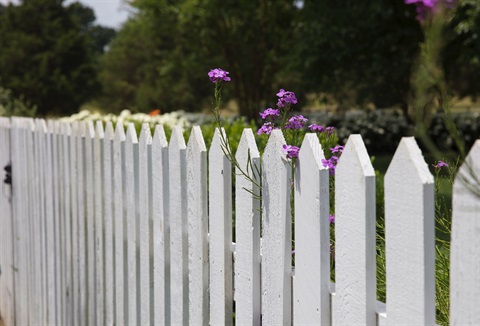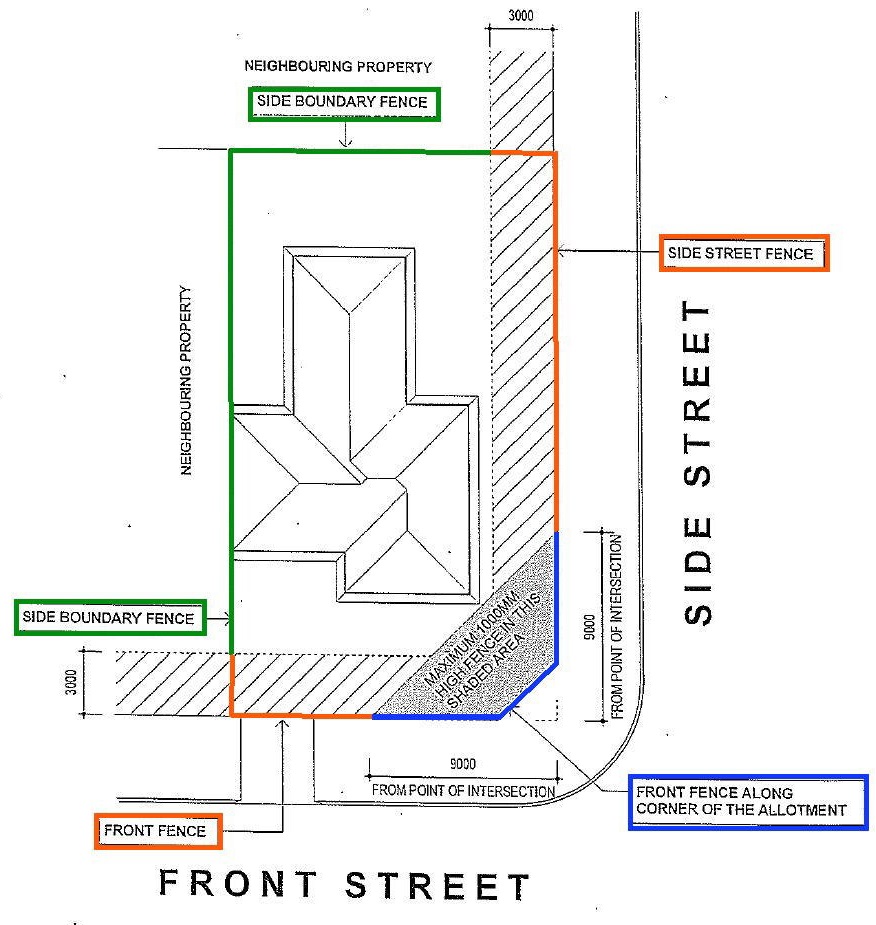Fences

Do I need a permit to build a fence?
You may need a permit for your fence depending on a few factors such as height, material and location on your property.
You may also need a planning permit, visit get planning advice.
Your land title may also have covenants or encumbrances that may further restrict or limit your fencing. Refer to an up-to-date copy land title via Landata for these.
All fences that form part of a swimming pool barrier (including boundary fences or a fence forming part of outdoor play space associated with children’s services) do require a building permit.

diagram – orange area
A building permit is required for the following:
-
Masonry fence over 1.2m, and over 1.5m for all other fences such as timber or steel
-
Barbed wire must be at least 150mm back from street alignment (boundary)
Corner fences
diagram – blue area
A building permit is required for the following:
Side street fence
diagram – orange area
A building permit is required for the following:
Side / rear boundaries
diagram – green area
A building permit is required for the following:
Notes on boundary fences – neighbour disputes
Boundary Fences are governed under the Fences Act 1968, the property owner and the neighbour are equally responsible for any dividing fence. The Act outlines things such as:
- who’ll pay for it
- what type to build
- what notices to send each other
- how to resolve disputes.
Dividing fencing between a Council public park or reserve and private freehold
The Fences Amendment Act 2014 exempts municipal councils from contributing to the cost of dividing fencing between Council public parks or reserves and private freehold. This amendment recognises that fences are an improvement to the freehold land. In July 2020 Council updated its boundary fencing policy(PDF, 154KB) to incorporate this change, and Council no longer contributes to dividing fencing with public parks, public reserves, linear reserves, roads, laneways and right-of-ways. Where the dividing fence abuts a Council owned car park or community facility (halls, libraries etc) Council will contribute half costs for repairs or replacements.
Fencing in Victoria
If you want to replace or repair the boundary fence, you or your neighbour need to reach an agreement or have a Magistrate decide for you. Your local Council has no authority to resolve disputes over fencing.
Here’s some helpful information:
Boundary fences are jointly owned property, whether on the boundary or not, and so both neighbours have rights and obligations.
Generally, the building or repairing costs are split 50/50. But this depends on factors such as:
- whether the fence needs replacing
- if one party wants a different or more expensive fence
- if one party has damaged the fence.
Typically, the new fence should be built the same as the old one but if one party wants something different they have to pay the extra cost. But both parties must agree.
Council approval generally is needed when properties have planning regulations - call our Planning Department on 03 5261 0600 before commencing any works to ensure you are not breaking any laws.
You should also refer to our information on fences (above) to ensure you are not breaching any building regulations – usually about height.
You need your neighbour’s consent, or to have followed the right legal process, before any building or repairing. If you don’t, you won’t be able to recover building or repair costs.
If you and your neighbour can’t agree, you can take it to the local Magistrates’ Court. Until then no one can be forced to do anything.
How can I resolve my fencing dispute?
Your local council is not there to resolve your dispute. That’s done in the local Magistrates’ Court.
If you have a fencing issue, please speak to the Dispute Settlement Centre for free confidential advice and strategies to assist you in resolving any issues.
Swimming pool and spa fences
-
Building permit is always required
-
Minimum height 1.2m
-
Specific construction requirements refer to Building Code of Australia, Volume 2, Australian Standard 1926.1 - 1993
Other Notes
-
Gates, screens and roller doors are included in these fence provisions
-
Excavations must be fenced or guarded during construction
-
Some Statutory Planning controls apply, please contact Statutory Planning on (03) 5261 0600
-
Fences adjoining Council Reserves, for example playgrounds, recreation groups, please contact Council on (03) 5261 0600.